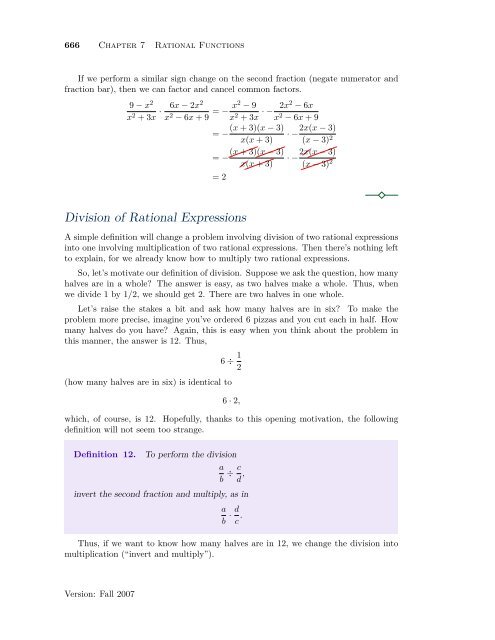Chapter 7 Rational Functions - College of the Redwoods
Chapter 7 Rational Functions - College of the Redwoods
Chapter 7 Rational Functions - College of the Redwoods
You also want an ePaper? Increase the reach of your titles
YUMPU automatically turns print PDFs into web optimized ePapers that Google loves.
666 <strong>Chapter</strong> 7 <strong>Rational</strong> <strong>Functions</strong><br />
If we perform a similar sign change on <strong>the</strong> second fraction (negate numerator and<br />
fraction bar), <strong>the</strong>n we can factor and cancel common factors.<br />
9 − x 2<br />
x 2 + 3x · 6x − 2x 2<br />
x 2 − 6x + 9 = − x2 − 9<br />
x 2 + 3x · − 2x2 − 6x<br />
x 2 − 6x + 9<br />
(x + 3)(x − 3) 2x(x − 3)<br />
= − · −<br />
x(x + 3) (x − 3) 2<br />
= −<br />
= 2<br />
(x + 3)(x − 3)<br />
x(x + 3)<br />
· −<br />
2x(x − 3)<br />
(x − 3) 2<br />
Division <strong>of</strong> <strong>Rational</strong> Expressions<br />
A simple definition will change a problem involving division <strong>of</strong> two rational expressions<br />
into one involving multiplication <strong>of</strong> two rational expressions. Then <strong>the</strong>re’s nothing left<br />
to explain, for we already know how to multiply two rational expressions.<br />
So, let’s motivate our definition <strong>of</strong> division. Suppose we ask <strong>the</strong> question, how many<br />
halves are in a whole? The answer is easy, as two halves make a whole. Thus, when<br />
we divide 1 by 1/2, we should get 2. There are two halves in one whole.<br />
Let’s raise <strong>the</strong> stakes a bit and ask how many halves are in six? To make <strong>the</strong><br />
problem more precise, imagine you’ve ordered 6 pizzas and you cut each in half. How<br />
many halves do you have? Again, this is easy when you think about <strong>the</strong> problem in<br />
this manner, <strong>the</strong> answer is 12. Thus,<br />
6 ÷ 1 2<br />
(how many halves are in six) is identical to<br />
6 · 2,<br />
which, <strong>of</strong> course, is 12. Hopefully, thanks to this opening motivation, <strong>the</strong> following<br />
definition will not seem too strange.<br />
Definition 12.<br />
To perform <strong>the</strong> division<br />
a<br />
b ÷ c d ,<br />
invert <strong>the</strong> second fraction and multiply, as in<br />
a<br />
b · d<br />
c .<br />
Thus, if we want to know how many halves are in 12, we change <strong>the</strong> division into<br />
multiplication (“invert and multiply”).<br />
Version: Fall 2007

















